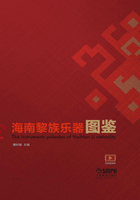
一、吹奏乐器
哩咧
Li lie

哩咧形制图

哩咧演奏图
哩咧又称“遭咧”“罗咧”,竹制竖吹单管乐器,黎族传统乐器。它分为管身和吹嘴两个部分,管身由长短粗细各不相同的竹管叠套而成。竹管的节数由五节到九节不等,最小的如拇指般大小,最大的可达30厘米以上。
哩咧的演奏指法与唢呐相似,音准、音色靠气息控制,吹奏技巧丰富,有打音、震舌、历音、叠音、颤音,还有单吐、双吐、花舌、滑音、断音、顿音等。
Lilie (“Zaolie” or “Luolie” in Li language) is a single-tube bamboo-made wind instrument that is blew vertically, and is a traditional instrument of the Li nationality. Each Lilie has two parts, namely the body and the mouthpiece. The body is made of different-size bamboo tubes arranged telescopically. There are generally five to nine sections of tubes of each Lilie, the smallest of which is as big as a thumb, while the biggest is over 30 cm.
The fingering of playing Lilie is similar to that of Suona (a double-reed horn, sometimes known as Chinese oboe or trumpet), the intonation and timber of which are controlled by the performer’s breath. There’s a variety of techniques in Lilie playing, including tapping, flutter tonguing, flying finger, multiphonics, trill, single tonguing, double tonguing, glissando, staccato and popped notes.

哩咧演奏图